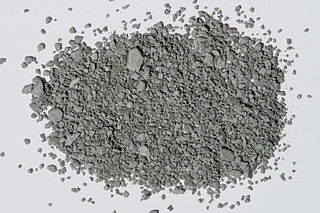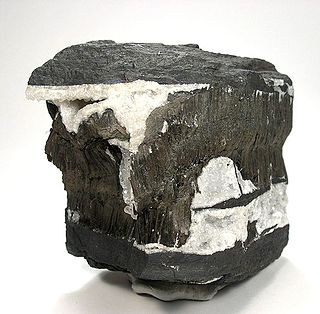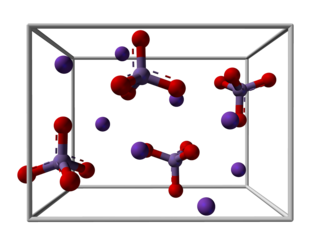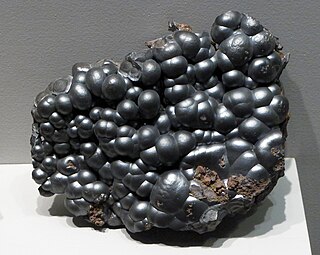Related Research Articles

Manganese is a chemical element; it has symbol Mn and atomic number 25. It is a hard, brittle, silvery metal, often found in minerals in combination with iron. Manganese was first isolated in the 1770s. Manganese is a transition metal with a multifaceted array of industrial alloy uses, particularly in stainless steels. It improves strength, workability, and resistance to wear. Manganese oxide is used as an oxidising agent; as a rubber additive; and in glass making, fertilisers, and ceramics. Manganese sulfate can be used as a fungicide.

Apatite is a group of phosphate minerals, usually hydroxyapatite, fluorapatite and chlorapatite, with high concentrations of OH−, F− and Cl− ion, respectively, in the crystal. The formula of the admixture of the three most common endmembers is written as Ca10(PO4)6(OH,F,Cl)2, and the crystal unit cell formulae of the individual minerals are written as Ca10(PO4)6(OH)2, Ca10(PO4)6F2 and Ca10(PO4)6Cl2.

Polymetallic nodules, also called manganese nodules, are mineral concretions on the sea bottom formed of concentric layers of iron and manganese hydroxides around a core. As nodules can be found in vast quantities, and contain valuable metals, deposits have been identified as a potential economic interest. Depending on their composition and autorial choice, they may also be called ferromanganese or polymetallic nodules. Ferromanganese nodules are mineral concretions composed of silicates and insoluble iron and manganese oxides that form on the ocean seafloor and terrestrial soils. The formation mechanism involves a series of redox oscillations driven by both abiotic and biotic processes. As a byproduct of pedogenesis, the specific composition of a ferromanganese nodule depends on the composition of the surrounding soil. The formation mechanisms and composition of the nodules allow for couplings with biogeochemical cycles beyond iron and manganese. The high relative abundance of nickel, copper, manganese, and other rare metals in nodules has increased interest in their use as a mining resource.

Manganese dioxide is the inorganic compound with the formula MnO
2. This blackish or brown solid occurs naturally as the mineral pyrolusite, which is the main ore of manganese and a component of manganese nodules. The principal use for MnO
2 is for dry-cell batteries, such as the alkaline battery and the zinc–carbon battery. MnO
2 is also used as a pigment and as a precursor to other manganese compounds, such as KMnO
4. It is used as a reagent in organic synthesis, for example, for the oxidation of allylic alcohols. MnO
2 has an α-polymorph that can incorporate a variety of atoms in the "tunnels" or "channels" between the manganese oxide octahedra. There is considerable interest in α-MnO
2 as a possible cathode for lithium-ion batteries.
Manganese oxide is any of a variety of manganese oxides and hydroxides. These include

Pyrolusite is a mineral consisting essentially of manganese dioxide (MnO2) and is important as an ore of manganese. It is a black, amorphous appearing mineral, often with a granular, fibrous, or columnar structure, sometimes forming reniform crusts. It has a metallic luster, a black or bluish-black streak, and readily soils the fingers. The specific gravity is about 4.8. Its name is from the Greek for fire and to wash, in reference to its use as a way to remove tints from glass.

Illite, also called hydromica or hydromuscovite, is a group of closely related non-expanding clay minerals. Illite is a secondary mineral precipitate, and an example of a phyllosilicate, or layered alumino-silicate. Its structure is a 2:1 sandwich of silica tetrahedron (T) – alumina octahedron (O) – silica tetrahedron (T) layers. The space between this T-O-T sequence of layers is occupied by poorly hydrated potassium cations which are responsible for the absence of swelling. Structurally, illite is quite similar to muscovite with slightly more silicon, magnesium, iron, and water and slightly less tetrahedral aluminium and interlayer potassium. The chemical formula is given as (K,H3O)(Al,Mg,Fe)2(Si,Al)4O10[(OH)2·(H2O)], but there is considerable ion (isomorphic) substitution. It occurs as aggregates of small monoclinic grey to white crystals. Due to the small size, positive identification usually requires x-ray diffraction or SEM-EDS analysis. Illite occurs as an altered product of muscovite and feldspar in weathering and hydrothermal environments; it may be a component of sericite. It is common in sediments, soils, and argillaceous sedimentary rocks as well as in some low grade metamorphic rocks. The iron-rich member of the illite group, glauconite, in sediments can be differentiated by x-ray analysis.

Todorokite is a complex hydrous manganese oxide mineral with generic chemical formula (Na,Ca,K,Ba,Sr)
1-x(Mn,Mg,Al)
6O
12·3-4H
2O. It was named in 1934 for the type locality, the Todoroki mine, Hokkaido, Japan. It belongs to the prismatic class 2/m of the monoclinic crystal system, but the angle β between the a and c axes is close to 90°, making it seem orthorhombic. It is a brown to black mineral which occurs in massive or tuberose forms. It is quite soft with a Mohs hardness of 1.5, and a specific gravity of 3.49 – 3.82. It is a component of deep ocean basin manganese nodules.

Potassium manganate is the inorganic compound with the formula K2MnO4. This green-colored salt is an intermediate in the industrial synthesis of potassium permanganate, a common chemical. Occasionally, potassium manganate and potassium permanganate are confused, but each compound's properties are distinct.

Romanèchite ((Ba,H2O)2(Mn4+,Mn3+)5O10) is the primary constituent of psilomelane, which is a mixture of minerals. Most psilomelane is not pure romanechite, so it is incorrect to consider them synonyms. Romanèchite is a valuable ore of manganese, which is used in steelmaking and sodium battery production. It has a monoclinic crystal structure, a hardness of 6 and a specific gravity of 4.7–5. Romanèchite's structure consists of 2 × 3 tunnels formed by MnO6 octahedra.

Birnessite (nominally MnO2·nH2O), also known as δ-MnO2, is a hydrous manganese dioxide mineral with a chemical formula of Na0.7Ca0.3Mn7O14·2.8H2O. It is the main manganese mineral species at the Earth's surface, and commonly occurs as fine-grained, poorly crystallized aggregates in soils, sediments, grain and rock coatings (e.g., desert varnish), and marine ferromanganese nodules and crusts. It was discovered at Birness, Aberdeenshire, Scotland.

Ferrihydrite (Fh) is a widespread hydrous ferric oxyhydroxide mineral at the Earth's surface, and a likely constituent in extraterrestrial materials. It forms in several types of environments, from freshwater to marine systems, aquifers to hydrothermal hot springs and scales, soils, and areas affected by mining. It can be precipitated directly from oxygenated iron-rich aqueous solutions, or by bacteria either as a result of a metabolic activity or passive sorption of dissolved iron followed by nucleation reactions. Ferrihydrite also occurs in the core of the ferritin protein from many living organisms, for the purpose of intra-cellular iron storage.

Tobermorite is a calcium silicate hydrate mineral with chemical formula: Ca5Si6O16(OH)2·4H2O or Ca5Si6(O,OH)18·5H2O.

George R. Rossman is an American mineralogist and the Professor of Mineralogy at the California Institute of Technology.

Bicchulite has an ideal chemical formula of 2CaO•Al2O2•SiO2•H2O, which was formularized from the hydrothermal synthesis of synthetic gehlenite. Also, bicchulite was sighted in the mines of Japan with related minerals. This sodalite-type structured bicchulite has an uncommon ratio of aluminium to silicon, causing difficulties deciphering the structure. Because of bicchulite's structure it has a powdery texture, which leads to complications in obtaining information on the mineral's physical properties. Despite this problem, the color, specific gravity, and crystal size of bicchulite are known. Although bicchulite was only discovered about 40 years ago, technology has been rapidly advancing, allowing more accurate results to be made from experiments done today.

Aluminoceladonite is a low-temperature potassium dioctahedral mica mineral which is an end-member in the illite-aluminoceladonite solid solution series. The chemical formula for aluminoceladonite is K(Mg,Fe2+)Al(Si4O10)(OH)2.

Serrabrancaite is a mineral with the chemical formula MnPO4•H2O and which is named for the locality where it was found, the Alto Serra Branca Pegmatite. The Alto Serra Branca mine has been in operation since the 1940s. It is located in Paraiba, Brazil near a village named Pedra Lavrada. Tantalite is the main mineral mined here. Specimens of serrabrancaite are kept in the Mineralogical Collections of both the Bergakademie Freiberg, Germany and the Martin-Luther Universität Halle, Institut für Geologische Wissenschaften.
Yangite (PbMnSi3O8•H2O) is a chain-silicate mineral, first discovered within the Kombat mine in Namibia. The mineral is named after Hexiong Yang, a researcher at the University of Arizona's Department of Geosciences. Yangite was approved as a valid mineral species by the International Mineralogical Association in 2012.

Alain Manceau, born September 19, 1955, is a French environmental mineralogist and biogeochemist. He is known for his research on the structure and reactivity of nanoparticulate iron and manganese oxides and clay minerals, on the crystal chemistry of strategic metals and rare-earth elements in marine sediments, and on the structural biogeochemistry of mercury in natural organic matter, animals, and humans.
References
- ↑ "Buserite". classicgems.net. Retrieved 2021-04-30.
- ↑ Kuma, Kenshi; Usui, Akira; Paplawsky, William; Gedulin, Benjamin; Arrhenius, Gustaf (1994). "Crystal structures of synthetic 7 Å and 10 Å manganates substituted by mono- and divalent cations". Mineralogical Magazine. 58: 425–447. doi:10.1180/minmag.1994.058.392.08. hdl: 2115/53250 .
- 1 2 Drits, V. A.; et al. (1997). "Structure of synthetic monoclinic Na-rich birnessite and hexagonal birnessite; I, Results from X-ray diffraction and selected-area electron diffraction". American Mineralogist. 82: 946–961. doi:10.2138/am-1997-9-1012.
- ↑ Usui, Akira (1995). "Geochemistry and Mineralogy of a Modern Buserite Deposit from a Hot Spring in Hokkaido, Japan". Clays and Clay Minerals. 43: 116–127. doi:10.1346/ccmn.1995.0430114.
- ↑ Manceau, Alain; Lanson, Martine; Geoffroy, Nicolas (2007). "Natural speciation of Ni, Zn, Ba, and As in ferromanganese coatings on quartz using X-ray fluorescence, absorption, and diffraction". Geochimica et Cosmochimica Acta. 71 (1): 95–128. doi:10.1016/j.gca.2006.08.036.
- ↑ Newton, Aric G.; Kwon, Kideok D. (2018). "Molecular simulations of hydrated phyllomanganates". Geochimica et Cosmochimica Acta. 235: 208–223. doi: 10.1016/j.gca.2018.05.021 . ISSN 0016-7037.
- ↑ Silvester, Ewen; Manceau, Alain; Drits, Victor A. (1997). "Structure of synthetic monoclinic Na-rich birnessite and hexagonal birnessite; II, Results from chemical studies and EXAFS spectroscopy". American Mineralogist. 82: 962–978. doi:10.2138/am-1997-9-1013.
- ↑ Manceau, A.; Lanson, M.; Takahashi, Y. (2014). "Mineralogy and crystal chemistry of Mn, Fe, Co, Ni, and Cu in a deep-sea Pacific polymetallic nodule". American Mineralogist. 99: 2068–2083. doi:10.2138/am-2014-4742.